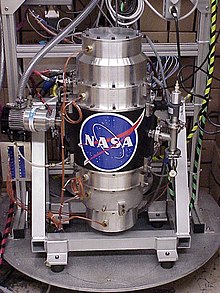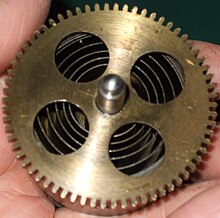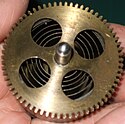Energilagring



Energilagring er det at gemme energi i en eller anden form, så den senere kan anvendes.
Fremtidig energilagringsmetode
I fremtiden kan det tænkes at man kan gemme energien i brint (besværligt at gemme) eller ætanol (ugiftigt, miljøvenligt og let at opbevare).
Mulige former for energilagring
- Mekanik
- Inertimoment. Energi kan gemmes i inertimoment i form af et roterende svinghjul.[1][2]
- Kinetisk energi:
- Potentiel energi:
- Gravitationel energi
- Dæmning. Den store mængde vand som er bag dæmningen, er potentiel energi der er lige til at tappe til mekanisk energi via en turbine eller vandmølle.
- Bornholmerur (kukur?). Gemmer potentiel energi i ét eller flere tunge lodder.
- "pælebanker", Guillotine.
- Gravity Power Module[3] Kombinér det med en slags frit fald sikring som i elevatorer – lås det monstertunge stempel fast – så fås (næsten) langtids tabsfri energilagring.
- Fjeder – I "gamle" dage skulle armbåndsure "trækkes" op. Optrækningen skulle stramme fjederen (mekanisk energi) i uret. For hver gang armbåndsuret svingede torsionsoscillatoren, blev der givet en lille mængde energi fra fjederen.
- Armbrøst, bue, blide, bjørnefælde, muldvarpefælde, musefælde, hoppestylte.
- Anvendes i nogle legetøjsbiler, som kan trækkes op.
- Elastik – Anvendes til afsendelse af små legetøjs fly og raketter. Andre legetøjsfly har en elastik som trækkes op med fingrene via propellen.
- Gravitationel energi
- Elektricitet
- Superleder. Elektrisk energi kan gemmes i en superleder i flere år.
- Elektrisk kondensator, ultrakondensator, nano-kondensator (f.eks. aerogel-baseret) – Er god til korttidslagring og kan normalt tåle høje strømstyrker (=hurtig op- og afladning); mindre end 1 sek.
- Elektrisk spole – Er god til korttidslagring og kan normalt tåle høje strømstyrker (=hurtig op- og af"fluxning?"); mindre end 0,1 sek. Anvendes f.eks. i SMPS.
- batterier.
- Termodynamik
- Trykforskel
- Lagertype: trykluftsflaske, trykkedel.
- Trykluft anvendes i mange toges døråbning- og lukningsmekanisme. Anvendes også til trykluftsbor og sømpistol. De gamle damplokomotiver og dampmaskiner havde et korttidslager i trykkedlen.
- Temperaturforskel – jordvarme, varmepatron.
- Trykforskel
- Kernefysik:
- Kemisk:
- Brintpille
- Akkumulator (elektrisk)
- Ethanol → brint → Brændselscelle[4]
- Majskolber kan omdannes til kulstofbriketter, som kan lagre metangas.[5]
- Biologisk
Kilder/referencer
- ^ Google: Flywheel Arkiveret 11. oktober 2004 hos Wayback Machine
- ^ "FAQ: Kinetic Energy Storage". Arkiveret fra originalen 2. december 2003. Hentet 16. november 2003.
- ^ Launchpoint: Gravity Power Featured in Water Power & Dam Construction Magazine (Webside ikke længere tilgængelig), Gravity Power’s innovative pumped storage hydropower technology, the Gravity Power Module, is the subject of a recent article in International Water Power and Dam Construction (IWPDC) (Webside ikke længere tilgængelig) Citat: "...His idea is called the Gravity Power Module (GPM) and, in concept, it is like a sealed water-filled piston...The pipes always remain full of water, including above and below the stack, whether it is stationary or moving..."
- ^ Ethanol som energilager: 2004-02-16, ScienceDaily: New Reactor Puts Hydrogen From Renewable Fuels Within Reach Arkiveret 21. marts 2004 hos Wayback Machine Citat: "...The first reactor capable of producing hydrogen from a renewable fuel source – ethanol – efficiently enough to hold economic potential has been invented by University of Minnesota engineers. When coupled with a hydrogen fuel cell, the unit – small enough to hold in your hand – could generate one kilowatt of power, almost enough to supply an average home, the researchers said...if you used ethanol to make hydrogen for a fuel cell, you would get 60 percent efficiency..."
- ^ February 21, 2007, Science Daily: From Farm Waste To Fuel Tanks: Record-breaking Methane Storage System Derived From Corncobs Arkiveret 23. februar 2007 hos Wayback Machine Citat: "...Pfeifer and his colleagues at MU and MRI discovered that that fractal pore spaces [i majskolber] (spaces created by repetition of similar patterns at different scales) are remarkably efficient at storing natural gas..."
Se også
Eksterne henvisninger
| Wikimedia Commons har medier relateret til: |
- energystorage.org Arkiveret 1. september 2004 hos Wayback Machine
- (engelsk) battery energy storage systemArkiveret 2022-05-26 hos Wayback Machine
|
Medier brugt på denne side
(c) Snthakur at bengali Wikipedia, CC BY-SA 3.0
Description=Image and diagram of Inductor
Source=This Image entirely is taken, drawn and edited by me in my notebook. Date=17 February 2008. Location=India, Kolkata, Madhyamgram. Author=Myself Permission=Permission is granted to copy, distribute and/or modify this document under the terms of the GNU Free Documentation License, Version 1.2 or any later version published by the Free Software Foundation; with no Invariant Sections, no Front-Cover Texts, and no Back-Cover Texts. A copy of the license is included in the section entitled "GNU Free Documentation License". .
Licensing=Not RequiredForfatter/Opretter: Deepak Gupta, Licens: CC BY-SA 4.0
Tata/MDI CAT compressed air car
Forfatter/Opretter: bizarroid, Licens: CC BY-SA 4.0
Realisé d'après un plan de modèle pour moteur caoutchouc, aux dimensions plus réduite, envergure 22cm, télécommande infrarouge trois voies (on remaque le volet de profondeur)
Skating; Schlossgarten Schwetzingen, lake
Forfatter/Opretter: HNH, Licens: CC BY-SA 3.0
The mainspring barrel from a clock. The mainspring which drives the clock, a coiled ribbon of spring steel, is visible inside the barrel. The clock is wound up by fitting a key onto the squared-off axle of the barrel (on other side) and turning it, winding the spring inside closer around the axle, storing energy in the spring. The other end of the spring is attached to the barrel. The force of the wound up spring turns the barrel, and the ring of gear teeth around the outside turns the clock's gears, until the spring runs down and needs to be wound again.
WARNING: Do not open the device you are seeing on the picture unless you have the special tools and training needed to perform this work. Mainsprings contain a lot of energy. Even a broken spring is powerful enough to injure you or others very seriously! Do not disassemble clockworks by yourself, unless you know how take the necessary precautions. Disassembly of a clockwork without such precautions may cause serious injury of you or other persons. You may also destroy the clock. These pictures are not presented here to inspire you to disassembly, but to give you the insights without having to disassemble a clockwork by yourself!








